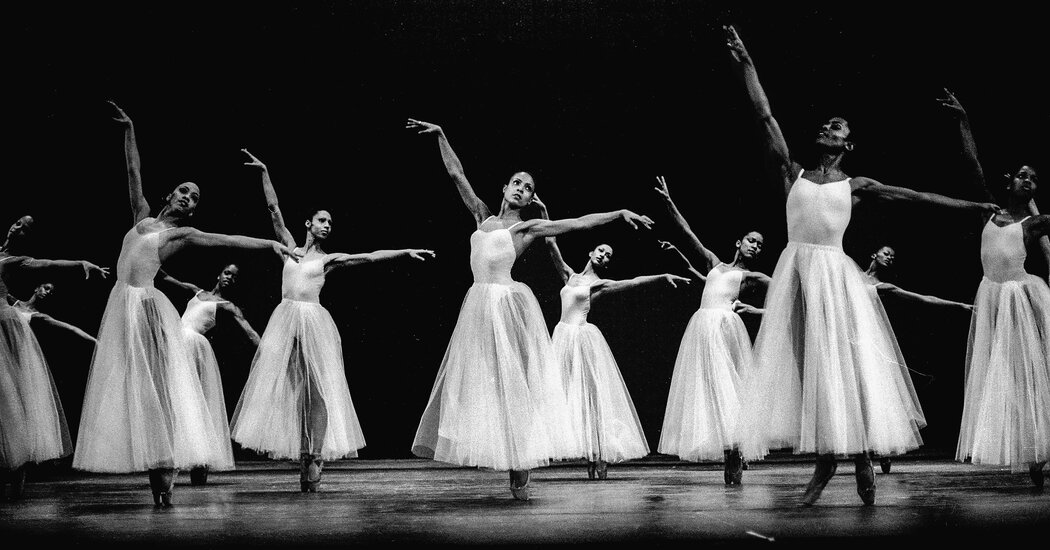THE SWANS OF HARLEM: Five Black Ballerinas, Fifty Years of Sisterhood, and Their Reclamation of a Groundbreaking History, by Karen Valby
The sense of loss in “The Swans of Harlem: Five Black Ballerinas, Fifty Years of Sisterhood, and Their Reclamation of a Groundbreaking History” is strong. No matter how painstaking the detail or how sparkly its jubilee energy, these women — Lydia Abarca, Gayle McKinney-Griffith, Sheila Rohan, Marcia Sells and Karlya Shelton — were robbed of laurels upon which they might now be resting. Abarca’s family was so concerned by her erasure from dance history (and her apparent attendant depression) that they instigated the telling of this story. If it were just a quest for cultural redress, the result might have been a dusty scroll of the Swans’ ballet bona fides. It’s by getting personal that it leaps high.
This is not to say that the book, which dances between narrative storytelling and as-told-tos, doesn’t give ballet’s broad strokes. The author, Karen Valby, skillfully maps the ugliness of a segregated art form in which too recently, blackface was still defended. And there are long looks at the idiosyncrasies of the Dance Theatre of Harlem’s co-founders, the charismatic ballet legends Karel Shook and Arthur Mitchell. The company was so influential that just two years after its 1969 founding, George Balanchine invited his former protégé, Mitchell, to share the stage with City Ballet at Lincoln Center. After that historic performance, members of the Bolshoi would dip into rehearsals to see, as one founding board member recalled, “dancers with athleticism and technique and exuberance and freshness and something to prove.” This was the Swans’ milieu.
All of this is absorbing. Yet it’s the odd details that shine brightest: Sells recalls painfully losing whole toenails while learning to dance on pointe — and eventually pirouetting with such speed that she could “feel the actual physics of it all.” At age 7, Rohan contracted polio, “a bird of a child with legs suddenly caged in thick braces.” Shelton recounts a fairy-tale first date during a stint in Paris, riding the Ferris wheel at Jardin des Tuileries. And what is most remembered about a performance to Tchaikovsky’s “Serenade for Strings” is “the transcendent scene of 17 women onstage, swathed in the palest and pearliest of blues.” Precisely because there’s so much meaning and humanity in this kind of minutiae, it has been methodically clipped from stories of Black women’s lives. It’s unsurprising that early news reports about the Swans and their cohort described them as “black slum youngsters.”
If asked about their homes, in fact, the Swans could have cited just as three examples: Staten Island’s tight-knit West Indian enclave, Connecticut’s green exurbs and the aspirational Black working class of Denver. If asked about their families, it might be on the record that Lydia’s softball-playing sister, Delores, loved watching her sibling at the barre. (“She let me be in my imagination for a bit.”) By their teens, these Swans’ lives were already being pruned for presentation to a hostile ballet universe. It’s a demonstration of radical vulnerability for them now to share, say, how they painted on and rinsed off chemical hair relaxers in backstage bathrooms.
Black women’s lives are too often told in summary, or rushed through in well-intentioned biopics that, in a more equitably greenlit world, would be 10-episode documentary series. Promising books flatten quickly to literary curriculum vitae, complete with palatable headshots and the centering of “firsts”: first Black woman this; first Black woman that. These five ballerinas claim their share of what we so benignly call “breaking barriers,” but the slothful pace of “change” that weights so many of those firsts can tarnish a trophy before it’s home.
The Swans are more than banners to be unrolled for Black History Month. But many of us minimize our own depth and fullness of character. It’s a soul-crushing habit we picked up hundreds of years ago. “For most of my career, I didn’t put my performing background on my résumé,” says Sells, who went on to become a dean of students at Harvard Law School and is currently the chief diversity officer at the Metropolitan Opera. “I thought it might make me sound unserious, to be frank. I thought people might think it was silly. But then when people did find out, they’d be like, Oh my God, you were an actual ballerina!”
Actual ballerinas: Abarca, McKinney-Griffith, Rohan, Sells and Shelton. Recognition delayed is recognition denied. And the process of reclamation is not only painful, like a dancer’s training, it is never quite complete. This expectation of being under-credited, and worse, the fear of being only superficially known, is why many Black ballerinas — many Black women — layer on mental Kevlar the way others do T-shirts and hoodies. It’s heavy. The moral of this important and tear-stained book is actually a reminder: Bare oneself, fly into the grandest of jetés and live free.
THE SWANS OF HARLEM: Five Black Ballerinas, Fifty Years of Sisterhood, and Their Reclamation of a Groundbreaking History | By Karen Valby | Pantheon | 304 pp. | $29







